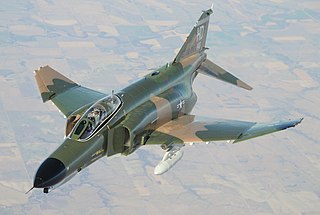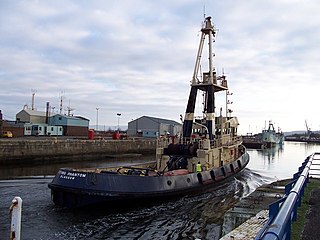
The McDonnell Douglas F-4 Phantom II is a tandem two-seat, twin-engine, all-weather, long-range supersonic jet interceptor and fighter-bomber originally developed for the United States Navy by McDonnell Aircraft. It first entered service in 1960 with the U.S. Navy. Proving highly adaptable, it was also adopted by the U.S. Marine Corps and the U.S. Air Force, and by the mid-1960s had become a major part of their air arms.

The McDonnell FH Phantom was a twinjet fighter aircraft designed and first flown during World War II for the United States Navy. The Phantom was the first purely jet-powered aircraft to land on an American aircraft carrier and the first jet deployed by the United States Marine Corps. Although with the end of the war, only 62 FH-1s were built, it helped prove the viability of carrier-based jet fighters. As McDonnell's first successful fighter, leading to the development of the follow-on F2H Banshee, which was one of the two most important naval jet fighters of the Korean War, it would also establish McDonnell as an important supplier of navy aircraft. When McDonnell chose to bring the name back with the Mach 2–class McDonnell Douglas F-4 Phantom II, it launched what would become the most versatile and widely used western combat aircraft of the Vietnam War era, adopted by the USAF and the US Navy, remaining in use with various countries to the present day.

A multihull is a ship or boat with more than one hull, whereas a vessel with a single hull is a monohull.

A catamaran is a multi-hulled watercraft featuring two parallel hulls of equal size. It is a geometry-stabilized craft, deriving its stability from its wide beam, rather than from a ballasted keel as with a monohull sailboat. Catamaran is from a Tamil word, kattumaram, which means "logs tied together".

The Flying Dutchman is a legendary ghost ship that can never make port and is doomed to sail the oceans forever. The myth is likely to have originated from the 17th-century golden age of the Dutch East India Company (VOC). The oldest extant version has been dated to the late 18th century. Sightings in the 19th and 20th centuries reported the ship to be glowing with ghostly light. If hailed by another ship, the crew of the Flying Dutchman will try to send messages to land, or to people long dead. In ocean lore, the sight of this phantom ship is a portent of doom.

TurboJET is the brand name for the operations of the Hong Kong-headquartered Shun Tak-China Travel Ship Management Limited, which was established from the joint venture between Shun Tak Holdings Limited and China Travel International Investment Hong Kong Limited in July 1999. It operates hydrofoil ferry services between Hong Kong, Macau, Shenzhen and Zhuhai, in the Pearl River Delta area.

Lake Victoria ferries are motor ships for ferry services carrying freight and/or vehicles and/or passengers among Uganda, Tanzania, and Kenya on Lake Victoria.

Incat Tasmania is a manufacturer of high-speed craft (HSC) catamaran ferries. Its greatest success has been with large, sea going passenger and vehicle ferries, but it has also built military transports and since 2015 it has built smaller river and bay ferries. Based in Derwent Park, a suburb of Hobart, Tasmania, Australia, it was founded by Bob Clifford.

Glenlee is a steel-hulled three-masted barque, built in 1896 for Glasgow owners, trading as a cargo ship. From 1922 she was a sail training ship in the Spanish Navy. She is now a museum ship at the Riverside Museum on Pointhouse Quay, Glasgow, known as The Tall Ship at Glasgow Harbour.

A sailing hydrofoil, hydrofoil sailboat, or hydrosail is a sailboat with wing-like foils mounted under the hull. As the craft increases its speed the hydrofoils lift the hull up and out of the water, greatly reducing wetted area, resulting in decreased drag and increased speed. A sailing hydrofoil can achieve speeds exceeding twice the wind speed.
Fullers Group Limited, trading as Fullers360, is a ferry and tourism company in Auckland, New Zealand. It operates in the Hauraki Gulf and Waitematā Harbour. Fullers Group is the latest in a long line of almost continuous harbour and gulf ferry operations based in Auckland since the 1870s.

MV Ali Cat is a motor catamaran passenger ferry owned by David MacBrayne Ltd and operated by Caledonian MacBrayne, which along with MV Argyll Flyer provides a service from Dunoon to Gourock across the Firth of Clyde.
The Dart 18 is a one-design 18-foot (5.5 m) long glassfibre sailing catamaran. It is designed to be sailed by two people and can achieve speeds of up to 20 knots.
This is reflected in its Portsmouth Yardstick of 805 and D-PN of 76.3

MV Clyde Clipper is a cruise boat, a purpose built catamaran with a capacity of around 250 passengers and facilities for weddings, functions and corporate hospitality, including bar and catering facilities. She was built by Abels Shipbuilders of Bristol in 2009.

James Wharram is a multihull pioneer and designer of catamarans.

The International B-class/F20 Catamaran, is a development class, on the comeback after the fracturing of the original B-class, into the myriad of one design, off the beach cats we have today.

The GC32 is a class of hydrofoiling catamaran conceived by Laurent Lenne of THE GREAT CUP BV. 32 feet in length and constructed of carbon fibre, these catamarans have a top speed of about 40 knots. They are sailed in the GC32 Racing Tour, and have replaced the Extreme 40's in the Extreme Sailing Series.
















